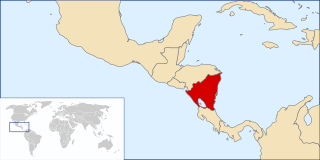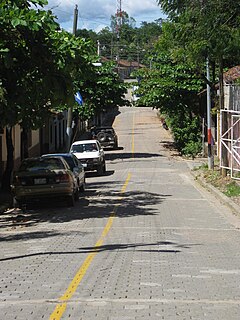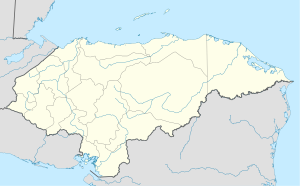
Esquipulas, officially Municipality of Esquipulas, whose original name was Yzquipulas, is a town, with a population of 18,667, and a municipality located in the department of Chiquimula, in eastern Guatemala. Esquipulas' main attraction is the beautiful Black Christ located in the Basilica of Esquipulas, making the town an important place of Catholic pilgrimage for Central America. It is also one of the most important towns of the country and one that has had the most economic and cultural growth.

Olancho is the largest of all the 18 departments into which Honduras is divided. The department covers a total surface area of 24,057 km² and has an estimated 2015 population of 537,306 inhabitants.

Chiquimula is one of the 22 departments of Guatemala, in Central America. The departmental capital is also called Chiquimula. The department was established by decree in 1871, and forms a part of the northeastern region of Guatemala. Physically, it is mountainous, with a climate that varies between tropical and temperate, depending on the location.

Matagalpa is a department in central Nicaragua. It covers an area of 6,804 km2 and has a population of 600,057. The capital is the city of Matagalpa with a population of about 111,000.
San Antonio del Norte is a municipality in the Honduran department of La Paz.

Lepaera is a municipality in the Honduran department of Lempira. It has tropical climate all year round.
El Negrito is a town, with a population of 12,790, and a municipality in the department of Yoro, Honduras.

Ocotepeque is a municipality in the Honduran department of Ocotepeque. The town of Nueva Ocotepeque is the municipal seat and the capital of the department.

Santa Fe is a municipality in the Honduran department of Ocotepeque. As of 2015, its population was of 5,006.
Guata is a municipality in the north west of the Honduran department of Olancho, west of Gualaco, north of Manto and east of Jano and Esquipulas del Norte.
Jano is a town and municipality in the north west of the Honduran department of Olancho, west of Guata, south of Esquipulas del Norte and north of Manto.

La Unión is a municipality in the northwest of the Olancho Department of Honduras.
Concepción del Norte is a municipality in the Honduran department of Santa Bárbara.
Nentón is a town and municipality in the Guatemalan department of Huehuetenango. Its territory extends 717 km2 with a population of 45,679. It became a municipality on December 5, 1876 and was formerly known as San Benito Nentón. The population speaks Spanish and Chuj.
Esquipulas is a municipality in the Matagalpa department of Nicaragua.

Esquipulas Palo Gordo is a town and municipality in the San Marcos department of Guatemala. The town was founded on 24 December 1826 year. In the 1920s it was merged with San Marcos, but in 1948 it recovered its autonomy again.

The following is an alphabetical list of topics related to Nicaragua.

San Juan de Cinco Pinos, colloquially known as Cinco Pinos, is a town and a municipality in the north of the Chinandega Department in Nicaragua, situated between San Pedro del Norte and Santo Tomás del Norte.
La Muralla National Park is a national park in Honduras. It was established on 1 January 1993. and covers an area of approximately 13,708.35 ha and a buffer zone of 13,195.05 ha for a total area of 26,903.48 ha.

Cristo Negros or Black Christs of Central America and Mexico trace their origins to the veneration of an image of Christ on a cross located in the Guatemalan town of Esquipulas, near the Honduran and El Salvadoran border. This image was sculpted in 1595 in wood and over time it blackened and gained a reputation for being miraculous. Little is known of how veneration of the image was spread by clergy, although there are records of its introduction in various locations, especially in Central America, southern Mexico, central Mexico and even as far north as New Mexico. However, a number of these images, such as the ones in Chalma, State of Mexico and Mérida, Yucatán have origin stories that do not connect the local image with that of Esquipulas. The Cristo Negro of Esquipulas remains an important symbol for Central America, with its sanctuary the most visited site in the region. On January 11, 2021, a replica of Christ of Esquipulas and his accompanying statues were donated to Saint Joseph Cathedral of Antigua Guatemala eliciting an uncontainable and renewed veneration for Black Christ of Esquipulas among his followers. There are hundreds of other such images with at least local importance with Christ of Chalma attracting millions of visitors, second only to that of the Virgin of Guadalupe in Mexico. The popularity of the image continues to spread, with Central American and Mexican migrants bringing the image to the United States and Canada, founding new sanctuaries.













